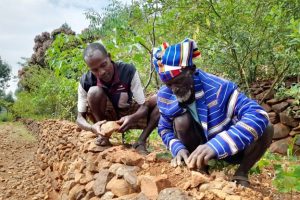
Ethiopia is a fascinating country with diverse historical, cultural and ecological blessings. The southern part of the country has amazing animal and plant species. It is extremely rich in flora and fauna. Among the ecologically rich areas in the country is found the Gurage Zone.
The Zone is found in the Southern Nations, Nationalities and Peoples State. The Gurage people are marked for their industriousness and traditional dishes known as Kitifo and Kocho. Enset in English is called false banana because it resembles somewhat a banana tree.

In the Gurage society’s culture, Enset is not cultivated for its fruit. Rather the stems and the roots are used as food after they passed through a careful preparation process. It is used to prepare Koche[for a flat bread]and Bula [a flour for porridage or soup] which are traditional foods of the Gurage people and other peoples of the state.

Hailu Kifleyesus, lecture at Jimma University, Department of Rural Development and Agricultural Extension told The Ethiopian Herald that Enset which is known scientifically as Enset Ventricosum belongs to musaceae plant species. There are 40 varieties of Enset and it is one of the longest plants with 12 meter height.
‘‘Enset looks like extruded onion with a globular stem and three meter long crescent leaves. Its stems should buried underground for fermentation for 3 to 6 months before they become ready for the preparation of Kocho bread, which looks like a big bread that is eaten with milk, cheese, cabbage and meat,’’ he notes.
Enset grows very well in lowland areas because it needs hot and temperate climates. In highlands, before it matures Enset takes three years from nursery to harvest whereas in the lowlands it takes only one third of the time. However, growing Enset is a very tiresome venture. ‘‘Enset is planted from the months of November to early February. These months are known as dry months in Ethiopia.
They are used to plant drought resistant plants. Enset holds water for years. What makes Enset special is, if drought hits, it simply stops growing and somewhat hibernates till the rain comes back. In fact, it is said it could survive up to seven years without rain,’’ he explains. When we see its growing process, Enset passes many stages before it becomes mature enough for harvest.
The whole process from the time of uprooting to the scraping, mixing, pressing, smashing and placing it in wells and so on is known as Wussatcha. Wussatcha is conducted by a group of women and they do it by turns. Enset is the main agricultural produce of Gurage people and it proved a viable solution for scarcity of land and overpopulation challenges.
‘‘Enset is becoming the stable food of millions of Ethiopians. Especially, the Gurages are predominantly dependnt on Enset as their primary agricultural produce so as to alleviate challenges related to soil erosion, soil infertility, land scarcity and overpopulation,’’ he said.
According to the scholar, Enset has many advantageous. Among them, it is used for preparing Kocho and Bula, for covering tables during meals, for covering water pots when water is brought from elsewhere, for fetching rain water, for protection during rain, for animal feeding, for shade during sunlight and for making ropes and mats. Besides, it could be used as medicine.
It is used to heal broken legs, arms, and other wounds. Ethiopia has been facing food insecurity due to seasonal drought and other factors for several years. Having understood this, the Ministry of Agriculture (MoA) has been striving to solve the problem through introducing drought resistant crop varieties.
Growing Enset is advisable as it could be a stable food for millions of low-income livelihoods. Hence, there are encouraging initiations from the government towards harvesting Enset and it should be scaled up in a modern manner.
The Ethiopian Herald Sunday Edition 7 July 2019
BY TSEGAY HAGOS





